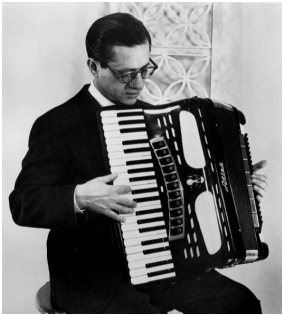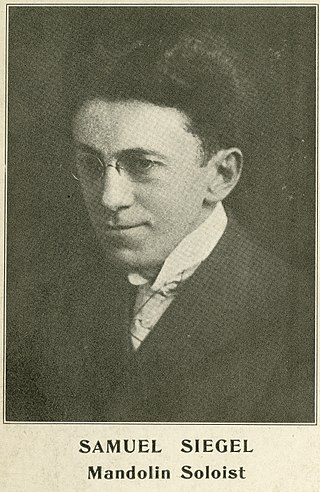
A mandolin is a stringed musical instrument in the lute family and is generally plucked with a pick. It most commonly has four courses of doubled strings tuned in unison, thus giving a total of eight strings. A variety of string types are used, with steel strings being the most common and usually the least expensive. The courses are typically tuned in an interval of perfect fifths, with the same tuning as a violin. Also, like the violin, it is the soprano member of a family that includes the mandola, octave mandolin, mandocello and mandobass.

Polka is a dance and genre of dance music originating in nineteenth-century Bohemia, now part of Czechia. Though associated with Czech culture, polka is popular throughout Europe and the Americas.

William Smith Monroe was an American mandolinist, singer, and songwriter, who created the bluegrass music genre. Because of this, he is often called the "Father of Bluegrass".

The Oak Ridge Boys are an American country and gospel vocal quartet originating in Oak Ridge, Tennessee. The group was founded in 1943 as the Oak Ridge Quartet. They became popular in Southern gospel during the 1950s. Their name was changed to the Oak Ridge Boys in the early 1960s, and they remained a gospel group until the mid-1970s, when they changed their image and concentrated on country music.

Mariachi is an ensemble of musicians that typically play ranchera, the regional Mexican music dating back to at least the 18th century, evolving over time in the countryside of various regions of western Mexico. The usual mariachi group today consists of as many as eight violins, two trumpets and at least one guitar, including a high-pitched vihuela and an acoustic bass guitar called a guitarrón, and all players taking turns singing lead and doing backup vocals.

Charles Samuel Bush is an American mandolinist who is considered an originator of progressive bluegrass music. In 2020, he was inducted into the International Bluegrass Music Hall of Fame as a member of New Grass Revival. He was inducted into the Hall of Fame a second time in 2023 as a solo artist.

The bandurria is a plucked chordophone from Spain, similar to the mandolin and bandola, primarily used in Spanish folk music, but also found in former Spanish colonies.

John Serry Sr. was an American concert accordionist, arranger, composer, organist, and educator. He performed on the CBS Radio and Television networks and contributed to Voice of America's cultural diplomacy initiatives during the Golden Age of Radio. He also concertized on the accordion as a member of several orchestras and jazz ensembles for nearly forty years between the 1930s and 1960s.
The Romaniacs was a Canadian rock band based in Vancouver, British Columbia. Their music combined Eastern European, Gypsy jazz, and pop. They made extensive use of costumes and props, including a large map, during their live shows.

Bernardo De Pace was an actor, musician and comedic vaudeville entertainer of the 1910s and 1920s, billed as "the Wizard of the Mandolin". He learned to play mandolin in the Italian tradition under Francesco Della Rosa. De Pace's repertoire and technique was described in the Brooklyn Life as involving "the most difficult violin and piano compositions, executed at inconceivably rapid tempi demanding an uncanny technique seldom heard on fretted instruments". In 1927 the Minneapolis Star said that he had been recognized as one of the best mandolinists in the United States. It added that he was more than a mandolinist, that his skill was in playing on human emotions as few musicians were able.
John Kruth is a singer/songwriter/multi-instrumentalist best known for his highly energetic "Banshee Mandolin” style of playing. He has also worked as a music journalist and has authored several book about popular music.

Bohumir Kryl was a Czech-American financial executive and art collector who is most famous as a cornetist, bandleader, and pioneer recording artist, for both his solo work and as a leader of popular and Bohemian bands. He was one of the major creative figures in the era of American music known as the "Golden Age of the Bands".

Samuel Siegel was an American mandolin virtuoso and composer who played mandolin on 29 records for Victor Records, including 9 pieces of his own composition and two that he arranged. Siegel was the first mandolinist to record on Emile Berliner's phonograph disk-records. He was labeled "America's Greatest Mandoline Virtuoso" and "The King of the Mandolin" in the May 1900 Banjo World.

Roy Hunter Butin was an American recording artist in the early 20th century, known for his playing of the harp guitar. He recorded more than a dozen early cylinder and 78 rpm records. From at least 1906 to 1916, he performed as one half of The Olivotti Troubadours with Michael Banner. Artists he recorded with also included Samuel Siegel, Valentine Abt, and W. Eugene Page.

Silas Seth Weeks was an American composer who played mandolin, violin, banjo and guitar. Although he played many instruments he concentrated professionally on the mandolin. He is considered to be the first African American to play mandolin during its golden period and was considered instrumental in bringing the mandolin to the prominent national standing that it had in the early 1900s. He was the first American known to write a mandolin concerto and led a mandolin and guitar orchestra in Tacoma, Washington.

Valentine Abt was an American composer who specialized in the mandolin. In the book Popular American Composers, Frank L. Boyden named Abt one of America's most "prominent specialists of the mandolin", saying that he should be appreciated in Europe as well as America as "one of the greatest artists of any instrument."

Johann Gottfried Eduard Bayer, usually known as Eduard Bayer, was a German composer for the classical guitar and a virtuoso performer on the guitar, harp guitar, mandolin and zither.

Carlo Curti, also known as Carlos Curti, was an Italian musician, composer and bandleader. He moved to the United States whose most lasting contribution to American society was popularizing the mandolin in American music by starting a national "grass-roots mandolin orchestra craze".

The mandolin has had a place in North American culture since the 1880s, when a "mandolin craze" began. The continent was a land of immigrants, including Italian immigrants, some of whom brought their mandolins with them. In spite of the mandolin having arrived in America, it was not in the cultural consciousness until after 1880 when the Spanish Students arrived on their international performing tour. Afterwards, a "mandolin craze" swept the United States, with large numbers of young people taking up the instrument and teachers such as Samuel Siegel touring the United States. The fad died out after World War I, but enough had learned the instrument that it remained. The mandolin found a new surge with the music of Bill Monroe; the Gibson F-5 mandolin he played, as well as other archtop instruments, became the American standard for mandolins. Bowlback mandolins were displaced. The instrument has been taken up in blues, bluegrass, jug-band music, country, rock, punk and other genres of music. While not as popular as the guitar, it is widespread across the country.

















